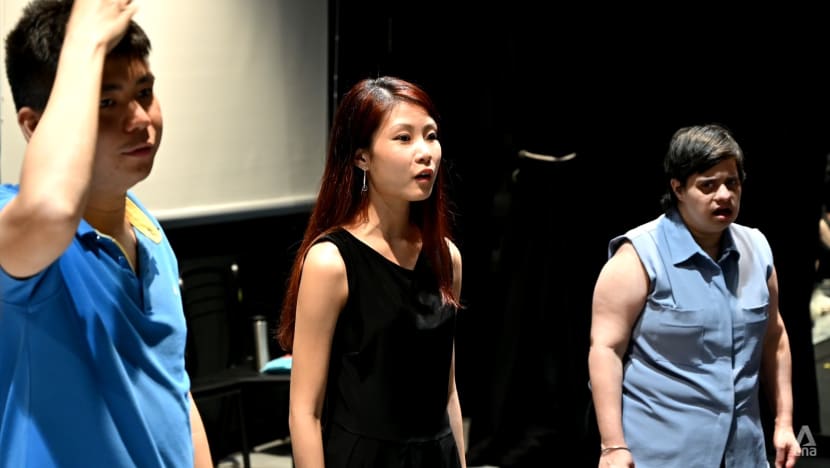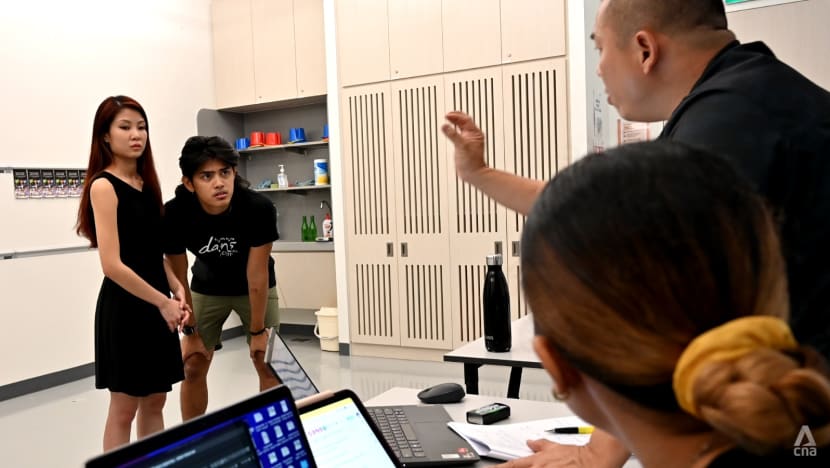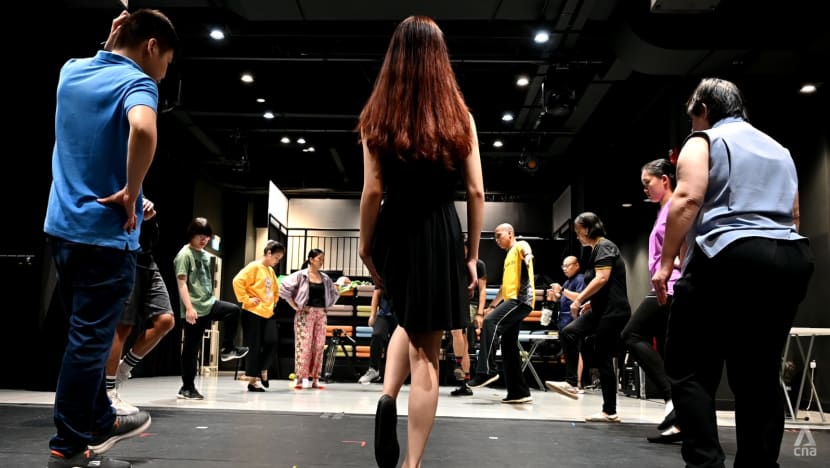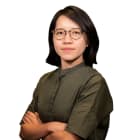'People underestimate me a lot': How a visually impaired actor fought her way to the stage
Claire Teo started losing her vision at the age of four. She tells CNA how her dream of being a star transformed into doing more for people with disabilities.

Actors Claire Teo (front) and Ammar Ameezy rehearse a scene for Chachambo: Taking Flight at ART:DIS on Jul 20, 2023. (Photo: CNA/Jeremy Long)
SINGAPORE: Artist-educator Claire Teo is used to being called a role model.
As the first visually impaired person in Singapore to graduate from a local professional theatre programme, she has been held up as an exemplar and was honoured at last year’s Goh Chok Tong Enable Awards.
Ms Teo is used to immersing herself in different personas for the stage, but playing a role model is a part about which she still feels ambivalent.
“If I am inspirational, does that mean I don’t need any more help? Does that mean there is nothing more society can do for me or can give me?” she told CNA in an interview before rehearsals for her latest production.
“It gets really tiring also, because if I’m strong, if I’m a role model, then does that mean I cannot be vulnerable?” she asked. “It has this connotation that I cannot be weak, I cannot have my crazy, childish moments.”
Ironically, the 23-year-old feels she can be most like herself on stage.
“When I’m performing, I can be vulnerable. I can be strong, I can be weak, I can be anything the performance asks (of) me, and no one will judge me for it.”

Ms Teo was diagnosed with retinitis pigmentosa at the age of four. The condition causes vision loss, with symptoms that include night blindness, loss of peripheral vision and colour deficiency.
Her young age meant she did not initially understand her condition, knowing only that she had to start wearing spectacles and go to school with a patch over one eye, then the other.
“My young brain could only understand that people were pointing at me and calling me ugly,” she said.
“My whole life just seemed to turn kind of upside down. But I don’t know any other way, because that is my life.”
Her vision loss is progressive. Now, what she can see resembles a kaleidoscope with a constantly moving array of patterns and colours in a space the size of a 10-cent coin.
It took her years to come to terms with her disability.
“I’ve always felt ashamed of my disability, maybe because I grew up with people telling me that I’m ‘poor thing’,” she said. “So if people keep telling me that I’m ‘poor thing’, then maybe I would feel ‘poor thing’ also.”
At the same time, she was “naive” about her motivations for acting. “I was this girl that was all for myself. I think I just wanted to be the star.”
Yet not everyone around her supported her dream to be an actor.
“There are many people in my life who may not have believed in the practicalities of being a performer, which is I think very, very normal for Asian families,” Ms Teo said.
People close to her doubted that she could earn a living by performing, and that she could move on stage and perform with others when she could not even see them.
“There are many of all these fears that people around me have projected. There are many of these doubts, and people underestimate me a lot. One, because I’m disabled, then I’m a girl, and then because I have a very petite frame.
“There are people who said no to my dreams, but I’ve never been a person who conformed easily. I’ve always been a very argumentative person, and I do what I want since young,” she said.
“I do what I want and I prove that it can be done my way.”

DISABLED PERFORMERS SEEN AS “PROBLEMATIC”
Ms Teo's shift away from her “naive”, “all for myself” thinking started six years ago, when she met fellow theatre practitioner Peter Sau.
Mainstream theatre practitioners who have worked with Ms Teo “don’t know what to do with her” nor how to create access for people with disabilities, said Mr Sau, who is the head of performing arts and artistic development at ART:DIS, a non-profit organisation for persons with disabilities in the arts.
This meant that she was often excluded when she attended drama workshops in the past, he said.
In auditions, for example, actors with sight can perform lines they have just received by reading the script. But visually impaired actors like Ms Teo will need to get the script in advance so they can memorise it, he pointed out.
“In fact, she will be the most prepared actor in the audition. Yet people don’t see it,” said Mr Sau, with most people instead focusing on the additional preparation time she needs.
“They will then start to think, if this is going to be for (the) audition, does that mean it’s for the rehearsal as well? And for the show? So why do I cast someone who is so problematic?”
Performers with disabilities “have all the talents, they just need to have all the barriers removed”. This means more time, planning and often, budget, and ultimately requires a change in the theatre ecosystem and drama schools, he said.
As she spent more time in theatre, Ms Teo came to realise that “there are real troubles that come with being disabled ... not just the opportunities, but the wages that we get, employability, opportunity to be trained”.
She credits Mr Sau with opening her eyes to what a disabled person in the arts could be capable of doing – for themselves and for others.
“It’s not just entertainment, but it is about what change it can bring,” as she realised that theatre “can be so much more than myself”.
“It is not that I can’t be Christine Daae on Broadway,” she said, referring to the female lead of the Phantom of the Opera, which used to be her dream role. “But what more can I do?
“If I can write a new version of Phantom of the Opera and I can produce it in Singapore with a full cast of disabled people ... then it is a bigger statement than what it is now.”

NO LONGER “CHARITY CASES”
That vision is becoming a reality. Ms Teo and Mr Sau are working together on a disability-led music theatre production, Chachambo: Taking Flight, which stages at the Victoria Theatre next month. She is the playwright and lead actor, with him directing.
She plays a young, visually impaired singer struggling to save an entertainment club while her mother’s legacy hangs over her. She described her character as an “entitled brat” who transforms into a leader.
The pan-disability cast comprises more than 90 performers across a range of disabilities and ages. The main cast of 11 includes persons with autism, Down Syndrome and muscular dystrophy as well as hearing and visually impaired performers.
A variety of strategies are used to help performers with different disabilities navigate the stage and script.
Visually impaired performers like Ms Teo use a mixture of memorising footsteps, sound cues and guiding by a sighted actor to move around the stage, according to Mr Sau.
Many of her scenes take place with her character’s love interest, played by deaf dancer and filmmaker Ammar Ameezy, who relies on lip-reading and visual cues to deliver his lines.
Ms Teo said the responsibility of developing a script that could showcase her fellow performers’ abilities scared, humbled and inspired her.
Her fear comes from knowing just how important the play is for all involved.
“We have always been seen as charity cases” and “inspirational heroes”, she said. But this also means “we haven’t been (held) to a very high standard”.
She hopes Chachambo can raise the bar for what is expected of disabled performers.
The production is a “report card” showing what they can do, and “an audition for all of us into the mainstream world”.
“I hope that one day it could just be the Singapore arts scene, and there’s no distinction between disability arts and mainstream arts,” she said.
Rehearsals for Chachambo have already started to make a difference.
Mr Sau recounted that the troupe was recently given time to carry out an “access audit” at Victoria Theatre – an alien concept for the local arts scene, where performers are usually charged for any use of the performance venue.
During the access audit, disabled performers get time to acquaint themselves with the space in a way that aids their performance.
For visually impaired performers, this can mean getting a sense of the size of the stage by using a white cane, then assisted by someone who is sighted, then using their own footsteps.
Mr Sau also used acoustics to help his actors perceive how far they have to project their voices and gestures, by standing at the farthest row of seats and shouting towards the stage.

ACCEPTANCE AND PRIDE
He acknowledged that working with a pan-disability cast requires more time – Chachambo has been in rehearsal for about four months, compared to the one month that a typical professional troupe requires.
The belief that “we should be reducing cost, we should be maximising time” is the biggest barrier to realising the artistic talents of persons with disabilities, Mr Sau said.
“Do we think of another alternative where we see them as assets and not deficits? That they are actually creative and not burdensome?” he questioned.
When she is not in rehearsal, Ms Teo works as a programmes executive at Methodist Welfare Services and teaches drama at Lighthouse School and MINDS, where she tries to be a mentor to younger performers with disabilities.
She said that many artists, herself included, do not want their disabilities to be highlighted and want to be recognised for their artistic work alone.
“But because Singapore is not at a point of being fully inclusive yet, we need the labels to keep fighting for our rights,” she said.
Her hope is that Singapore and its arts scene will be more open to collaboration with persons with disabilities.
“What society can do is just be open to receiving, be open to working with persons with disabilities, because disability is a catalyst for innovation and for creativity.
“You know our whole (lives), we have been working with limitations. So our problem-solving skills are amazing, and we are extremely creative about it.”
Working with persons with disabilities may take more time and resources, but “the returns are more” too, she said.
“Because you learn more from people you have never worked with, you will learn more from new perspectives, and the work you create will have more facades. It will have more layers to it that you have never discovered before, because you have never worked with that community as deeply.”
Ms Teo now feels acceptance and pride towards her disability.
“My eyesight, my disability makes me the person I am today. It gave me the chance, the knowledge to fight for people to bring more meaning into the work that I do.
“This is me, this is my disability. It makes me the person and the artist I am and I’m very, very proud of it.”
The Goh Chok Tong Enable Fund (GCTEF) is a community fund that aims to provide people with disabilities the opportunities to actively contribute to society and lead socially integrated lives. The fund is administered by SG Enable and supported by Mediacorp. Emeritus Senior Minister Goh Chok Tong is the fund's patron. To support people with disabilities through the GCTEF, visit GCTenablefund.sg.

















